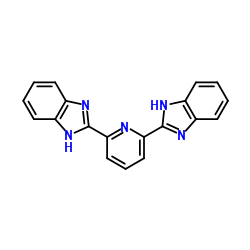2,6-双(2-苯基咪唑)

2,6-双(2-苯基咪唑)结构式

|
常用名 | 2,6-双(2-苯基咪唑) | 英文名 | tcmdc-123507 |
|---|---|---|---|---|
| CAS号 | 28020-73-7 | 分子量 | 311.340 | |
| 密度 | 1.4±0.1 g/cm3 | 沸点 | 664.0±65.0 °C at 760 mmHg | |
| 分子式 | C19H13N5 | 熔点 | 300ºC | |
| MSDS | 美版 | 闪点 | 311.4±27.2 °C | |
| 符号 |

GHS07 |
信号词 | Warning |
|
2, 6-Bis (2-benzimidazolyl) pyridine as a chemosensor for fluoride ions. Chetia B and Iyer PK.
Tetrahedron Lett. 49(1) , 94-97., (2008)
|
|
|
Utilization of 2, 6-bis (2-benzimidazolyl) pyridine to detect toxic benzene metabolites. Chetia B and Iyer PK.
Tetrahedron Lett. 48(1) , 47-50, (2007)
|
|
|
A V-shaped ligand 2,6-bis(2-benzimidazolyl)pyridine and its picrate Mn(II) complex: synthesis, crystal structure and DNA-binding properties.
Eur. J. Med. Chem. 45(11) , 5324-30, (2010) A V-shaped ligand 2,6-bis(2-benzimidazolyl)pyridine (bbp) and its picrate Mn(II) complex have been synthesized and characterized by elemental analysis, molecular conductivities, (1)H NMR, IR, UV-vis spectra and X-ray single crystal diffraction. The crystal st... |
|
|
A highly selective optical sensor for aniline recognition.
Spectrochim. Acta. A. Mol. Biomol. Spectrosc. 74(5) , 1060-3, (2009) In this paper, an optical sensor, 2,6-bis(2-benzimidazolyl)pyridine, is reported to be highly selective towards aniline. A unique spectral response of 2,6-bis(2-benzimidazolyl)pyridine towards aniline is found, and a linear relationship between the sensor's e... |
|
|
Toward equatorial planarity about uranyl: synthesis and structure of tridentate nitrogen-donor {UO2}2+ complexes.
Inorg. Chem. 53(5) , 2506-15, (2014) The reaction of UO2Cl2·3THF with the tridentate nitrogen donor ligand 2,6-bis(2-benzimidazolyl)pyridine (H2BBP) in pyridine leads to the formation of three different complexes: [(UO2)(H2BBP)Cl2] (1), [(UO)2(HBBP)(Py)Cl] (2), and [(UO2)(BBP)(Py)2] (3) after su... |
|
|
Acetate recognition by 2,6-bis(2-benzimidazolyl)pyridine.
Spectrochim. Acta. A. Mol. Biomol. Spectrosc. 81(1) , 313-6, (2011) 2,6-Bis(2-benzimidazolyl)pyridine, bbp, a simple tridentate ligand, is employed as a receptor for the recognition of anions. The binding of anionic guest species with bbp can be studied in short duration using UV/vis spectroscopy, fluorescence spectroscopy an... |